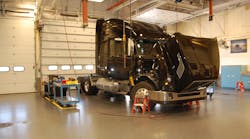Volvo Trucks North America (VTNA) is touting its involvement in the SuperTruck program – and public-private research effort spearheaded by sponsored by the U.S. Department of Energy (DOE) – as one of the main reasons its been able to develop more fuel efficient powertrain designs for the 2017 model year.
“The DOE’s support, together with the skill of our powertrain engineers working on the SuperTruck program, helped generate significant powertrain innovations,” said Gӧran Nyberg, VTNA’s president, in a statement.
Nyberg – who helped unveil some of those innovations during a special event in Hagerstown, MD, last month – pointed out that the SuperTruck program is a cost-shared partnership between the DOE, truck OEMs, engine makers, and other component suppliers aimed at boosting the efficiency of heavy-duty Class 8 long-haul tractor-trailers.
He said developments made by VTNA as a result of its participation in the SuperTruck project include:
- Wave Piston: This new design added “wave” bumps on the side of the piston bowl, which allows diesel fuel to burn more cleanly, reducing fuel consumption while significantly reducing soot generation. This new patented wave piston, working in combination other enhancements – such as a new common rail fuel system – boosts fuel efficiency up to 2.2% for the OEM’s D11 engine and 2.5% for the D13 model.
- Turbo Compounding: This new turbo systems is designed to recover heat lost through the combustion process. On the 2017 model D13 engine equipped with turbo compounding, VTNA said fuel efficiency can be increased by up to 6.5%.
- Common Rail Fuel Injection System: VTNA designed a new common rail fuel injection system for its 2017 model D11 and D13 engines to enable a higher injection pressure, which improves combustion, and allows for finer control of the injection event, with enhanced flow rate, spray angle and pressure characteristics of the injectors allowing the engine to operate more quietly and burn fuel more efficiently.
- Transmission fine-tuning: VTNA said the SuperTruck program allowed its engineers to refine the peak efficiency in the “sweet spot” for Volvo’s integrated powertrain solution, which includes the I-Shift automated manual transmission (AMT)and downsped engines.



